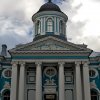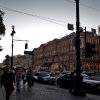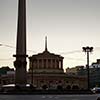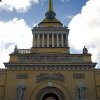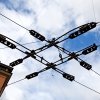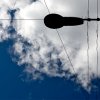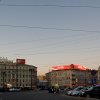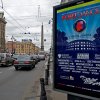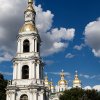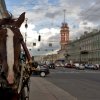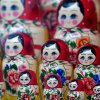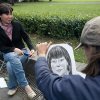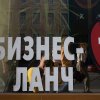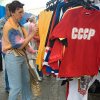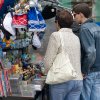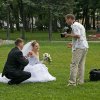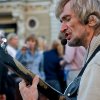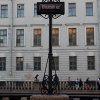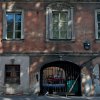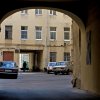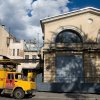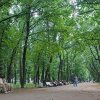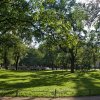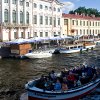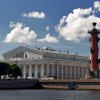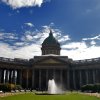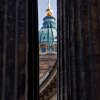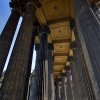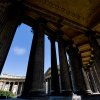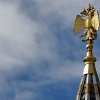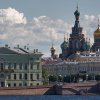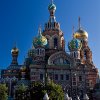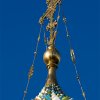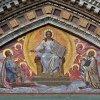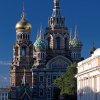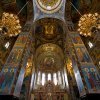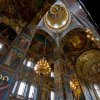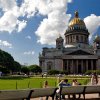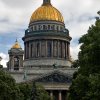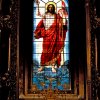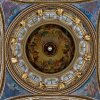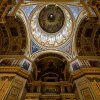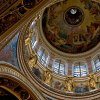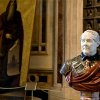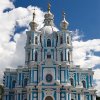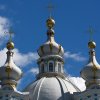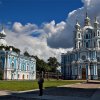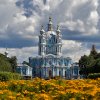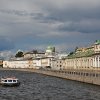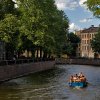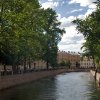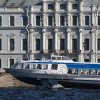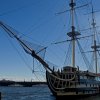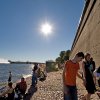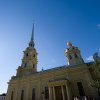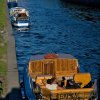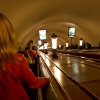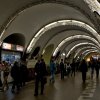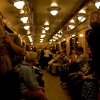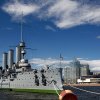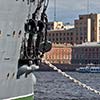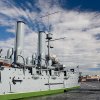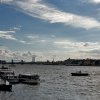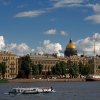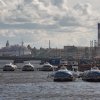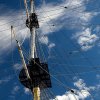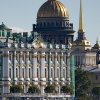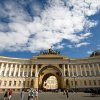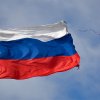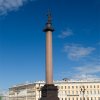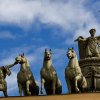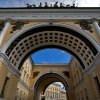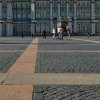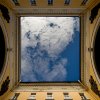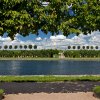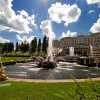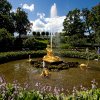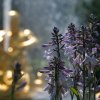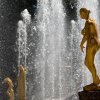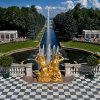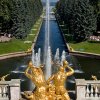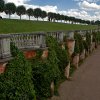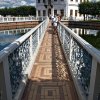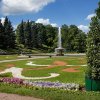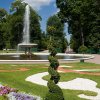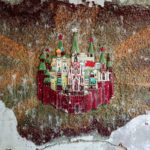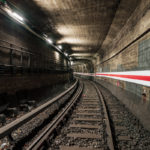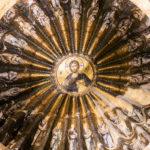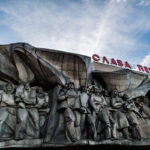Saint Petersburg – Venice of The North
Gracefully does the world’s most northern metropolis frame its geographic aorta, Neva River. Saint Petersburg has always been the actual centre of power of the Russian emperors. In midtown their presence is clearly perceptible, even almost visible. The old Petro- and Leningrad is worth to spend more days than only a weekend. It is a city where a unique history meets a sensational culture and architecture standing alone for itself. In the face of such pomp it is not surprising that then in 1917 starving population revolted against the emperor to limit the royal show-off by a worldwide unique regulation: communism. Beside all things called history Saint Petersburg is also the present stage of for example inimitable festivals like Fortdance (-> click here for a review + photos).
Even if Russian summer temperatures cannot compete with those of the Italian lagoon metropolis, the attribute Venice of the North is quite applicable though. No other city outside of Western Europe appears to be more “European”, no other northern city is characterized by romantic water veins, intimate lanes and lovely bridges in such a manner. Only when the contact wires of the trolley busses start to dominate the townscape, the picture of the European exclave gets a certain Russian self-dynamics.
When doing the first steps on Russian soil slowly memories of once learned special vocabulary came back. Памятник (pamyatnik), monument – замок (samok), castle – собор (sobor), cathedral – извините мне пожалуйста (isvinitye mnye poshalista), excuse me please and so on… It’s interesting to see (or better to read) Russian Anglicisms as due to Cyrillic letters those actually English words give the city scape some additional curio.
Peter, as the city is lovingly called by inhabitants, lies on 60th latitude and knocks on the door of the Artic region as it’s located at the same height like Greenland’s southern tip or southern Alaska. At summer solstice visitors can experience a top-notch spectacle, the white nights. That state of missing total blackout has already been a great delight for e.g. Dostoyevsky. It is like an ever lasting Blue Hour. Unfortunately at that time of the year, from mid June to mid July, hotel prices are incredibly high: being accommodated in a normal 2-star hotel will easily cost a price of 100 Euro per night. To people who don’t want to feed multinational companies I recommend renting a private flat.
The city of Saint Petersburg is rambling; it’s no problem to spend a day walking more than 15km. Even big Nevsky Prospect is breathtakingly 4km long. Along that avenue there can already be found the first sights worth seeing. For example the Kasan Cathedral ((Казанский Cобор) and its spacious colonnades directly residing at the Nevsky, which is visible for miles around. That sacred building had been constructed by Andrey Worochin and with its 71m high dome it immediately reminds of Saint Peter’s Basilica in Rome. That appearance was even intended; when coming back from Rome Tsar Paul I was inspired by the one and only mother church of Catholicism and ordered Worochin to build a similar cathedral.
Slightly hidden and only some meters north-eastern of Kasan Cathedral, the Resurrection Church (Церковь “Спаса на Крови”) can be found. That Russian style church with its conspicuous bulbous spires is directly residing at the banks of Griboyedova Canal (Канал Грибоедова). For the usual 300 roubles also the interior of that present-day museum can be lionised. The church was built on the place where on March 1st 1881 Tsar Alexander II had been assassinated. Its interior is graced by many colourful Byzantine style mosaics; in fact there’s no free space left for more mosaics as everything is painted already. That appears a bit surreal when making yourself clear that in Soviet times the church was misused as potato storehouse.
Saint Isaac’s Cathedral (Исаакиевский Cобор) is approaching the eye of the beholder in a similar way the Resurrection Church does, since that sacred building is also colourful, multifaceted and embellished with polished marble, precious and semi-precious stones. But unlike its bulbous spire counterpart it is much bigger; its interior gives shelter to more than 14000 believers. Architect Auguste de Montferrand was responsible for constructing Russia’s tallest and also biggest orthodox church of the world. Carrying out construction works took about 40 years (1818-58), while the work itself was basically spread over the shoulders of more than half a million bondservants. The cathedral is buttressed and graced by 112 massive granite pillars which are even weighing up to 114 tons singly.
In Saint Petersburg’s northeast and a little off the beaten track there’s another sight worth seeing: the beautiful arrangement of classical Smolny Cathedral (Смольный Cобор). Due to the city’s flat development the white domes with its golden crucifixes as well as the cathedral’s shining blue face are visible for kilometres. When construction works began back in 1748 Smolny was intended to house a school for aristocratic girls. It got its finish in the middle of 19th century under reign of Nicholas I. Located not far away from Smolny is the “Dictatorship of the Proletariat” square, yet another piece active of piece of history and “overseen” by Marx, Engels as well as Lenin whose busts are standing in the park nearby.
The Neva River (Нева) is omnipresent in St. Pete. Its main part is indeed almost half a kilometre wide while its widely ramified net of small canals dominates the cityscape. On its banks, especially around Peter and Paul Fortress (Петропавловская Крепость) you can relax and lean back while watching the bustle on the water – Oststrand feeling au naturel. Last but not least the amazing hydrofoil crafts are an eye catcher as those Raketa called monsters are making their way through the waves speedy at about 60km/h.
The Neva River isn’t only wide, it is also deep. Like in Moscow the metro stations of St. Pete are a place of interest on its own. Due to the river’s depth endless escalators are transporting masses of people to a level of even 100m below sea level. Sometimes one is riding the escalators for about 2 minutes. Several metro stations are equipped with bulkhead-like doors to protect from water possibly breaking in. In Soviet times that protection against the river was intended to serve in a different way: as a giant underground bunker in case of an US-American nuclear strike.
On the northern side of Neva River, where the main stream is splitting the first time, the permanently moored cruiser Aurora (Аврора) can be found. The battle ship is a major symbol of the great Communist Revolution in Russia. A blank cartridge gunshot by Aurora served as a start signal to storm the Winter Palace, the main estate of Russian Tsars.
On the other river side, obliquely opposite of Aurora, one can find that aforementioned Winter Palace, which resides in an illustrious neighbourhood; framed by the Board of Admiralty (Адмиралтейство), the Palace or respectively Alexander Square (Дворцовая Площадь) and the General Staff building with its triumphal arch (Арка Генерального Штаба). In the middle of the square the Alexander Column (Александрийский Столп) is reminding of Russia’s victory over Napoleon. Today the Winter Palace accommodates parts of the world-famous Hermitage (Эрмитаж) and its unique art treasures.
As seen on the city map, some decent distance to the left, the main estate of Tsar Peter can be found. So called Peterhof (Петергоф) is directly located at the Gulf of Finland. Due to its very beautiful and large park and numerous big and small fountains Peterhof is also referred to as Russian Versailles. The most impressive fountain is undoubtedly the Samson Fountain, which beside its protagonist Samson in the centre is framed by plenty of golden statues. When following the paths to the eastern part of that park one will surely spot the smaller Marli Palace with its colonnades of trees and the bigger man-made rectangular lake.
Travel Hints
Applying for the visa directly at the Russian embassy requires time, a local consulate as well as the ability to assert yourself. Asserting yourself against the particular clerk isn’t the only necessary thing; you’ll also need to stand up to all the other applicants as at any time of day the consulate is packed. It is much more stress-free and worth the little extra fee to get your visa from a visa service. When arriving in Russia one of the first actions has to be the registration of your visa. Despite the still existing migration card procedure you have to report in most cases to your hotel reception. In all other tourism related cases now visa registration is possible at the post offices (link to Rossiskaya Gaseta).
More extensive photo equipment should be mentioned in the customs declaration.
Unfortunately another rather negative topic has to be mentioned as well: crime. None of the world’s big cities has ever got rid of it. However, when considering the high count as well as the destinations of my travels, then it’s the pits that of all cities the most brazen pilfering manoeuver was attempted in Saint Petersburg. Among the crowd on Nevsky Prospect someone tried to distract me by advertising some bad postcard prints. In my case such guys don’t have any chance. However his “work” came to fruition as the other 3 guys got 2-3 seconds, which was enough time to open my locked photo backpack unnoticedly while I was walking. It was enough time for them to manage to steal my 100-400 tele lens. Only due to watching the shadows behind me, a fast as lightning reaction and using “little” violence I am still the owner of my 100-400. Well, watch your belongings when being among lots of people! This also applies to the Metro.
But let’s get back to a not unimportant hint, the ride from Pulkovo airport to the city center using public transfer. The Marshrutkas are only leaving from the international terminal Pulkovo 2. A Marshrutka is a shared taxi, often a van, which follows a constant route; in this case to Moskovskaya metro station (line 2), from there you can start your journey to the city centre. It’s recommended to purchase a season ticket instead of endlessly buying chips called jeton. That ticket is valid for 7 or more days and can be used for 10 or more rides. To boot a ride is even cheaper then.
Used photo equipment: Canon EOS 1D Mark III, Canon EF 24-70 2.8L, Canon EF 50 1.4, Sigma EX 12-24, Canon EF 100-400L.
Further Links:
- Metro in St. Petersburg – http://www.metro.spb.ru
- My Review and Photos of Fortdance 2007
